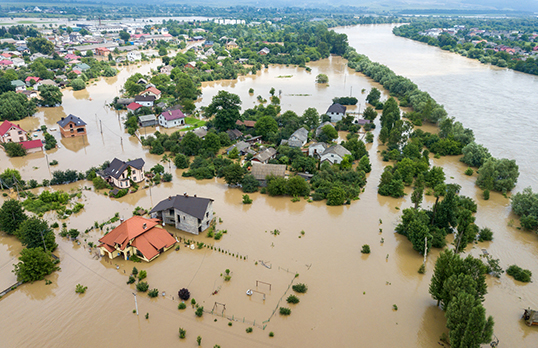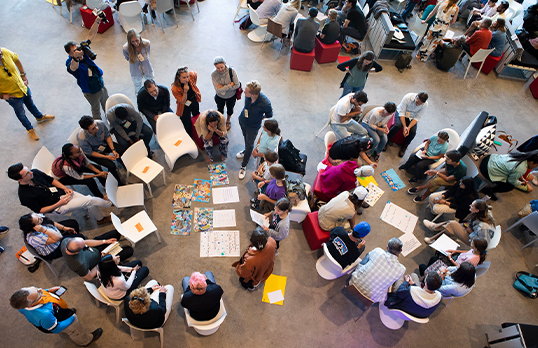This wide-ranging theme breaks down into four discrete scans addressing: mitigation of carbon emissions, climate adaptation, biodiversity, and the role of engagement and activism. The topics are, however, all intrinsically linked and vital to fully tackling the scale of the challenge.

Abimbola Windapo and Alice Moncaster discuss climate change mitigation where focusing on carbon emissions reduction and driving the net zero transition is pressing. The next decade is our last chance if we are to ensure a liveable planet for future generations.
Read Horizons 2034: mitigating carbon emissions (exclusive to RIBA Members)

Ronita Bardhan looks at the next 10 years, where sustainable design will no longer be just about carbon emissions reduction and shifting to net zero. The onset of climate change will require adaptation of the existing built environment to ensure it is resilient to increasingly adverse weather conditions.
Read Horizons 2034: climate adaptations (exclusive to RIBA Members)

Harriet Bulkeley highlights how the protection of life on Earth is crucial for mitigating the impact of global warming on ecosystems. Biodiversity is most often tackled in the context of natural landscapes. As rural species decline in the coming decade, the significance of urban habitats for nature must be realised.
Read Horizons 2034: biodiversity (exclusive to RIBA Members)

Chris Luebkeman and Jonelle Simunich discuss how combatting climate change and its impacts requires engagement and activism. Only by taking individual and collective action, raising awareness and developing professional knowledge and expertise, can a universal commitment be made to a sustainable future.
Read Horizons 2034: engagement and activism (exclusive to RIBA Members)
The environmental challenge facing us is both vast and urgent.
Use of energy and materials is increasing globally, greenhouse gas emissions are going up rather than down, the devastating impacts of climate change are already being suffered from sub-Saharan Africa to the poles, and the crisis in global biodiversity is unprecedented.
Vested interests, lack of understanding, and inertia are compounding the problems. As Latour asks in Down to Earth: “How can we not feel inwardly undone by the anxiety of not knowing how to respond?” [1]
Architects and built environment professionals have a particular responsibility. As highlighted in the International Energy Agency and United Nations Environment Programme Global Status Report 2022, greenhouse gas emissions arising from heating, cooling and lighting our buildings are responsible for 27% of global emissions. [2] Constructing and maintaining those buildings emits an additional 10%, with construction of infrastructure responsible for another 10%. Our built environment, then, is responsible for almost half of all global emissions – and, by implication, so are its architects.
At the same time, urbanisation, more extreme weather, growing populations and increasing migration are exerting an ever-greater pressure on our cities. The need for resilient buildings to shelter us all in comfort and security from the heat and storms to come is only going to grow.
The only possible answer to the climate crisis is to recognise our global responsibility, even as the political mood swings towards nationalisation. How should architects respond professionally to both this responsibility and this demand, in the next ten years and beyond?
The current system of education and skills, manufacturers and supply chains, procurement and finance, and developers and design firms, is so unwieldy that it is no surprise that the construction industry is seen as one of the slowest to change. And yet change is happening. An understanding of the importance of improving energy efficiency is now widespread and enshrined in regulations across much of the world. The measurement and gradual reduction of embodied carbon in building materials is finally starting to catch up, with national regulations just introduced in the Scandinavian countries and spreading.
But professional training and practices still tend to reflect old siloes based on rigid divisions of knowledge and labour. They still respond to a conceptual framework which sees buildings and infrastructure as technologies made up of individual parts, rather than integrated socio-technical systems. This has too often produced battles rather than consensus: arguments over whether operational or embodied carbon is the most important, over heavy-weight versus lightweight structures, over demolition versus retention, and over densification versus low-rise.
Radical change – indeed revolution – is needed, and this is what RIBA Horizons 2034 is challenging us to achieve.
The four Horizons 2034 topics are overlapping and inter-connected. Degradation of the environment is unfairly experienced at both global and local scales, with economic systems increasingly protecting the rich at the expense of the poor and vulnerable. Population growth and migration add additional pressures. Technological innovation is often held out as the holy grail, and yet repeatedly fails to reduce carbon emissions, often instead producing unintended negative consequences.
Within The Environmental Challenge theme, we are considering mitigation, adaptation, biodiversity, and the role of engagement and activism.
Biodiversity and protecting the variety of life on Earth in all its forms is also crucial in ameliorating the impact of global warming on ecosystems and preventing local environmental degradation. However, driving change at a policy and an individual level requires engagement and activism in a cycle of continuous debate and lobbying. These areas are intrinsically linked.
So, this is how architects must respond. They must rethink the boundaries of their responsibilities and start a revolution. Revolution is needed all along the supply chain, to produce near-to-zero carbon products and buildings.
But revolution is also needed at the point at which projects are first imagined, at the point at which planning is approved or denied, throughout the design professions and the construction industry and within regional and national governments.
Building professionals must reconsider their role, not as great designers of new objects to be admired and consumed, but as servants of global communities who need more from their built environment than ever before.
And rather than working in siloes, they need to learn about and practice maths, art, humanity and understanding – and above all humility.
Change is needed in the ways that decisions are made, in the arguments that are openly had, those that are hidden, and those that are never discussed.
Every step of our approach to the built environment must be deconstructed, in order to reassemble it as one that is fit for the future, that minimises our impact as a species on the climate and on earth’s ecosystems, and that provides us with a built environment capable of sustaining our future on the planet.
References
[1] Bruno Latour (2018). Down to Earth: Politics in the New Climatic Regime (Catherine Porter, Trans.). Polity Press
[2] Global Alliance for Buildings and Construction (9 November 2022). International Energy Agency and United Nations Environment Programme Global Status Report 2022
About the author
Alice Moncaster is Professor of Sustainable Construction at the University of the West of England, following academic posts at the Open University and the University of Cambridge, and degrees from Cambridge (BA and MA), Bristol (MSc) and UEA (PhD).
She seeks through her research and writing to challenge the status quo in the construction sector, thereby achieving a radical transition towards environmental sustainability and resilience to climate change.
She works with national and international partners across disciplines and retains a close link with practitioners and industry.
RIBA Horizons 2034 is a foresight-gathering programme that highlights the most significant global trends of the near future – shaping society, the built environment, and the architectural profession. View the latest information on other themes and scans.